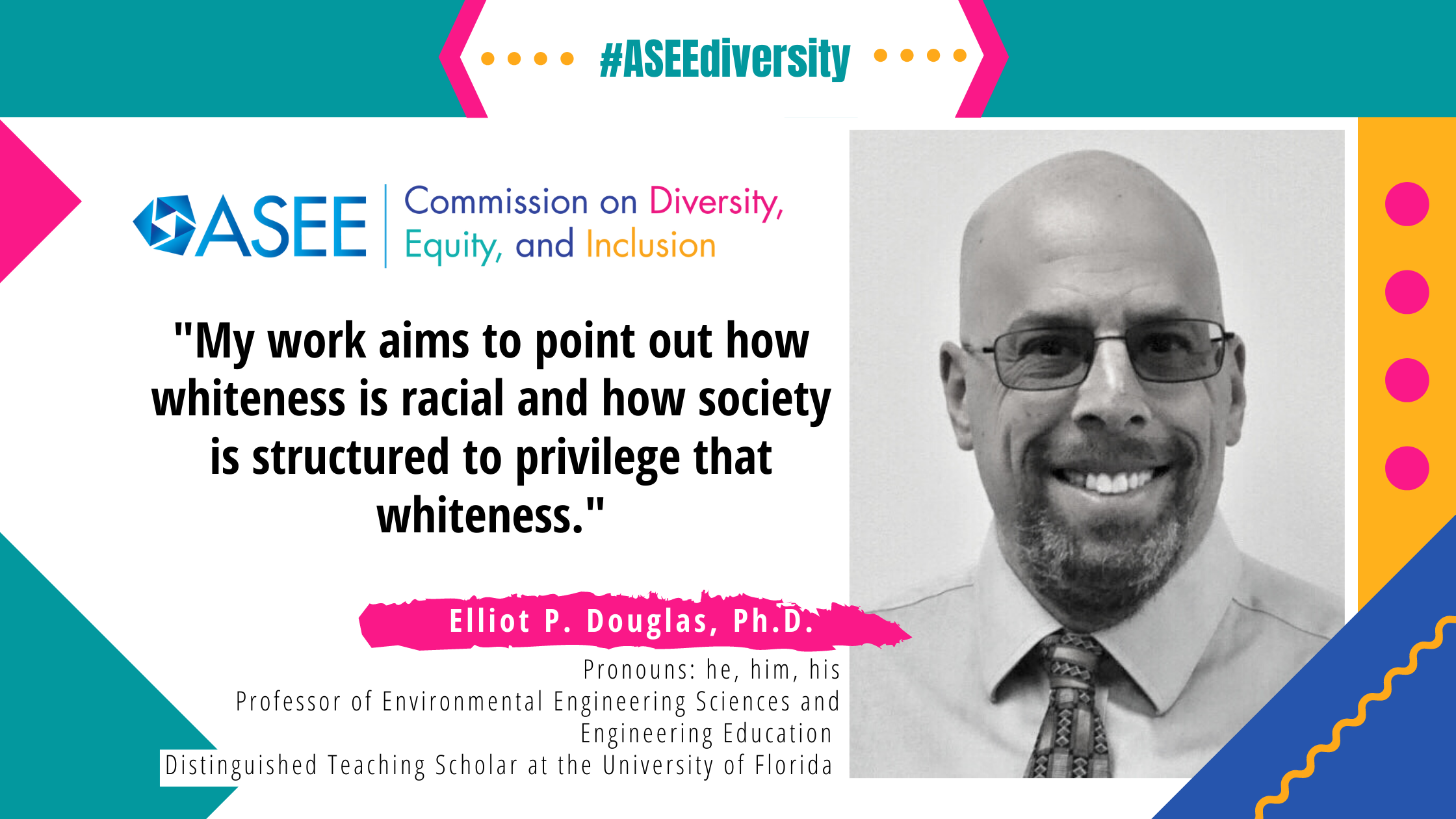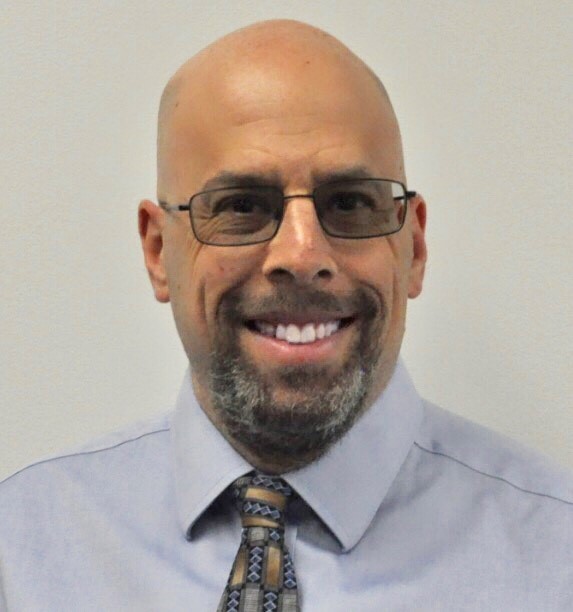
ASEE CDEI Scholar Spotlight Series: Elliot P. Douglas, Ph.D.
 Elliot P. Douglas, Ph.D.: studying how cultures of engineering workplaces are structured to privilege normative behaviors
Elliot P. Douglas, Ph.D.: studying how cultures of engineering workplaces are structured to privilege normative behaviors
In this blog post, we will hear the story of Dr. Elliot P. Douglas, a Professor of Environmental Engineering Sciences and Engineering Education, and Distinguished Teaching Scholar at the University of Florida.
Elliot’s interest in research are in engineering problem solving, diversity and inclusion, and social justice for engineering ethics. He has served as Associate Editor and Deputy Editor of the Journal of Engineering Education, Chair of the Educational Research & Methods Division of ASEE, and Program Director for Engineering Education at the US National Science Foundation. He received S.B. degrees from MIT in 1988 and a Ph.D. from the University of Massachusetts – Amherst in 1993.
I am sure that Elliot’s belongingness story in this interview will resonate with many of you. Enjoy!
At the end of this post, don’t miss out on the opportunity to connect with our scholar and learn more about the ASEE CDEI‘s efforts.
ASEE CDEI Communications Committee Volunteers:
- Introduction, editor and webmaster: Sindia M. Rivera-Jiménez, Ph.D., University of Florida (Twitter)
- Editors: Susan Boerchers, Lafayette College; Tershia Pinder-Grover, University of Michigan, Homero Murzi (Twitter), Virginia Tech, and Elizabeth Litzler, University of Washington.
Scholar Interview
Q1: Can you tell us your story of belongingness?
My story of belongingness has fluctuated over time, taking me in and out of feeling like I belonged to the intellectual community I was part of. Growing up, I always knew I wanted to do something related to science. My father was a chemical engineer, and I would sometimes see work he brought home. I remember seeing his Ph.D. dissertation on water desalination and thinking about how science could be used to help people. I chose my major, materials engineering, because of one professor who explained everyday phenomena related to materials engineering (like why the sky is blue). I decided on my Ph.D. department for essentially the same reason; I was fascinated by the unique properties of polymers and how the same material could have vastly different properties depending on environmental conditions. My first job at Los Alamos National Laboratory allowed me to continue exploring the behavior of these materials.
But even as I followed this path of research, I was always interested in teaching. As a graduate student, I tutored a friend through the qualifying exams. At Los Alamos, I considered trying to teach at the local campus of the University of New Mexico, but it wasn’t practical with my job responsibilities. Eventually, I decided to leave Los Alamos for an academic position and ended up at the University of Florida.
This time at UF began with a renewed sense of belonging. However, that started to change as I realized that I was “too” focused on teaching for a research-intensive university. I worked on various faculty development programs, both inside and outside of UF, and sought ways to measure my own teaching. A turning point came when I attended a workshop on engineering education research and joined that community. Since then, I have found my intellectual home among my fellow engineering education researchers.
Q2: What is your understanding of Diversity, Equity, and Inclusion (DEI), and why is it important to what you do?

Dr. Elliot P. Douglas
he, him, his
University of Florida
As a white male, DEI was never something that impacted me directly. While I always thought diversity was important, it never seemed like something that I had anything to say about. Then I saw a talk about privilege, and it made me realize that I could address DEI from my perspective as a white person. Now I see DEI as an issue of privilege and structure. I live in a position in which I benefit from these structures, and it is my responsibility to identify where those structures exist and how I benefit from them. White people don’t consider themselves to have a racial identity – race is something that is “other.” My work aims to point out how whiteness is racial and how society is structured to privilege that whiteness.
Q3: What are your current initiatives towards DEI work?
I currently have an NSF-funded research project exploring the experiences of Black engineers in the industry. For this project, I work with a great team of researchers: Professor Erica McCray at UF, Ph.D. student Gretchen Dietz, and Paul Richardson, who is a long-time engineer and the one who initially approached me about starting this work. We want to understand the cultures of engineering workplaces and how they are structured to privilege normative behaviors. For example, “professional expectations” can lead to a lack of belonging when those expectations are rooted in normative white culture.
Within UF, I am the chair of my department’s Inclusion, Diversity, Equity, and Access (IDEA) Committee and serve on the Herbert Wertheim College of Engineering’s IDEA Committee. I want the committee open to all who are interested in contributing, and it includes faculty (tenure and non-tenure track), staff, post-docs, graduate students, and undergraduate students. I see my role as committee chair as facilitating the DEI work that its members want to do. Activities have ranged from social media campaigns to ongoing development of a mentoring program to data collection to understand the department’s current status.
Q4: What do you see as the next steps for your DEI work?
My goal is to make changes in the communities I am part of. I see my first steps as learning – What are the experiences of minoritized individuals? What are the organizational structures that perpetuate normative expectations? This information is critical to supporting change that is substantial and meaningful. However, as someone who is part of the majority, I don’t always understand what concrete actions can be taken to address racism, sexism, ableism, etc. I try to mix learning and action because action can’t wait until everyone is “on board.”
Q5: What recommendations do you have for engineering educators to start incorporating social justice in their classrooms?
Social justice, and societal issues in general, need to be better integrated into the engineering curriculum. Many people have written about the social/technical divide in engineering (Erin Cech, University of Michigan; Donna Riley, Purdue University; and many others). Social issues need to be incorporated into all classes at every level, so students come to see engineering as an integrated socio-technical field. I have another project on problem-solving, and the engineers we have interviewed consistently say that they weren’t prepared for how much non-technical work they need to do. So whatever class you are teaching, whether it is an introductory class like statics or an advanced analysis class, find ways to incorporate social aspects. One interesting approach has been undertaken by Susan Lord at the University of San Diego, who developed a module on conflict minerals for a circuits class.
Q6: What resource can you recommend to people who want to learn more about DEI in your field?
There are so many good resources it is hard to narrow it down! A few suggestions are:
A history of how engineering education was structured to be racist is Slaton, A. E. (2010). Race, rigor, and selectivity in U.S. engineering. The history of an occupational color line. Cambridge, MA: Harvard University Press.
An overview of critical theories on race: Mejia, J. A., Revelo, R. A., Villanueva, I., & Mejia, J. (2018). Critical theoretical frameworks in engineering education: An anti-deficit and liberative approach. Education Sciences, 8(158).
A good example of using a critical theory to interrogate structural issues is Pawley, A. L. (2019). Learning from small numbers: Studying ruling relations that gender and race the structure of U.S. engineering education. Journal of Engineering Education, 108(1), 13-31.
I wrote a paper as I was beginning my DEI work, primarily in order to get my own thoughts together: Douglas, E. P. (2015). Engineering as a space of white privilege. Understanding & Dismantling Privilege, V(1), 36-44.

Elliot Douglas inducted as an ASEE Fellow.
Recommended ASEE PEER paper from our scholar:
Dietz, G. A., & Douglas, E. P., & McCray, E. D. (2021, January), Marginalization and the In/authentic Workplace Experiences of Engineers Paper presented at 2021 CoNECD, Virtual – 1pm to 5pm Eastern Time Each Day . https://peer.asee.org/36108
Abstract Excerpt: “In this presentation we document a narrative exploration of how three women in engineering, with marginalized identities, view aspects of the workplace culture affecting the extent to which they can authentically be themselves. Furthermore, we assess how these engineers describe prejudice and oppression within their workplaces. The data presented within this paper were collected as part of a larger NSF-funded study qualitatively assessing the manifestation of racism within the technology industry.”
Find more articles on ASEE Peer for this scholar: Elliot P. Douglas
Connect with our scholar:
Getting involved with CDEI
- If you want to recommend someone for our Spotlight series click here.
- Check out website Highlights:
- Resources
- Past Blogs and Events
- Compilation of Newsletters and Reports
- Connect with the committee:
- Become a Friend of the Committee
- Follow us and tag us on Twitter
- Become a volunteer on our Communications Committee! We are always looking for people that want to share or improve their writing and leadership skills.
Check out other Spotlight Scholars:
- Dr. Homero Murzi: Creating culturally responsive environments by focusing on the voices of our engineering students (September, 2020)
- Dr. Tony E. Butterfield: Empowering faculty and students to create an inclusive environment for the LGBTQ+ community (October, 2020)
- Dr. Carlotta A. Berry: From trailblazer to building a strong community and network to foster allyship and confidence among engineering students (February, 2021)
- Dr. Lindsay Soh: From actively maintaining a sense of belongingness to helping others develop their own (March, 2021)
- Dr. Idalis Villanueva-Alarcón: Using her experiences in liminality served as a lens for research scholarship that challenges normative ways of learning. (April 2021)
- Brianna Benedict: Building a community of educators passionate about diversity, equity, and inclusion in engineering education. (May, 2021)
- Liz Litzler: A look into our 2020-2021 chair of the ASEE Commission on Diversity, Equity, and Inclusion, CDEI (July, 2021)
